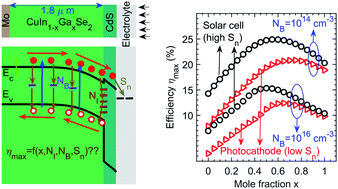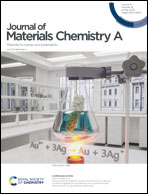Theoretical perspective of performance-limiting parameters of Cu(In1−xGax)Se2-based photocathodes†
Abstract
With the ever-increasing demand for energy globally, artificial photosynthesis through photoelectrochemical water splitting has attracted attention as a promising approach to realize sustainable and environmentally friendly energy resources. Because of the excellent efficiency improvement of photovoltaics, considerable research has focused on the development of Cu(In1−xGax)Se2 (CIGS)-based photocathodes for efficient hydrogen evolution. To optimize devices and materials for photocathodes, it is imperative to understand the physics behind the generation, separation, and transport of charge carriers. Here, CdS/CIGS-based photocathodes are modeled using optical and electrical simulations to study such effects and unravel various performance-limiting parameters. The model is well calibrated with experimental results. Specifically, we show that (a) the solar-to-hydrogen conversion or ideal regenerative cell efficiency is strongly governed by the defects at the CdS/CIGS interface, mole fraction x (=[Ga]/([Ga] + [In])), bulk defects in CIGS, and surface reaction rate of electrons with protons, (b) the onset potential saturation with increasing mole fraction is caused by defect states at the CdS/CIGS interface, (c) the optimized mole fraction for maximum efficiency is higher than the corresponding one for solar cells. These results represent an important step towards building a theoretical platform for the development of p–n heterojunction photocatalytic devices.



 Please wait while we load your content...
Please wait while we load your content...